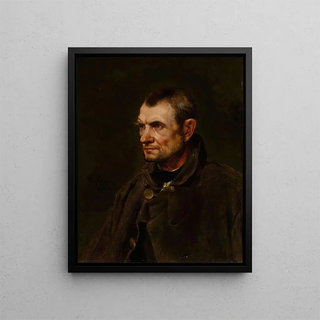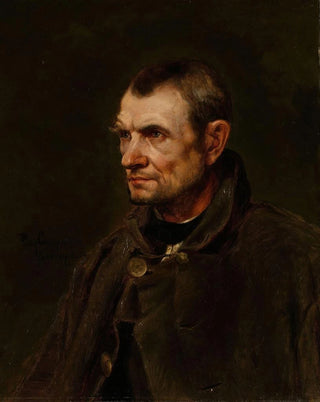Art print | Study of the farmer Florian Killian figure - Eilif Peterssen Source: Reproduction | Étude de figure du fermier Florian Killian - Eilif Peterssen


View from behind

Frame (optional)
In the world of art, certain works transcend the mere frame to become living testimonies of their era. The art print "Étude de figure du fermier Florian Killian - Eilif Peterssen" embodies this essence by offering a penetrating look into rural life in the 19th century. This piece, both intimate and universal, invites the viewer to immerse themselves in the farmer's universe, revealing the struggles and joys of a profession often overlooked. Approaching this representation, one immediately feels the connection between man and land, a sacred bond that evokes centuries of tradition and craftsmanship.
Style and uniqueness of the work
Eilif Peterssen's work stands out for its ability to blend realism and sensitivity. In this study, the farmer Florian Killian is depicted with meticulous attention to detail, each fold of his clothing and every expression on his face telling a story. The chosen colors, both earthy and vibrant, evoke Nordic landscapes, while the light plays a central role, illuminating the subject in an almost divine manner. This stylistic choice not only pays homage to rural life but also captures a deeply human essence. Peterssen, through his approach, manages to establish a dialogue between the viewer and the subject, making this piece an immersive experience.
The artist and his influence
Eilif Peterssen, an emblematic figure of the Norwegian artistic movement, left his mark on his era with works that combine tradition and modernity. Influenced by naturalism and romanticism, he developed a style that is uniquely his own, characterized by a particular attention to light and texture. Peterssen was also a passionate advocate for Norwegian culture, seeking to highlight the traditions and landscapes of his country through his art. His influence extends far beyond his creations, inspiring many contemporary artists to explore similar themes, notably the relationship between man and his environment. By choosing to depict a farmer in his work, he emphasizes the importance of rural life in the Norwegian national narrative, while celebrating the heritage.

Matte finish

View from behind

Frame (optional)
In the world of art, certain works transcend the mere frame to become living testimonies of their era. The art print "Étude de figure du fermier Florian Killian - Eilif Peterssen" embodies this essence by offering a penetrating look into rural life in the 19th century. This piece, both intimate and universal, invites the viewer to immerse themselves in the farmer's universe, revealing the struggles and joys of a profession often overlooked. Approaching this representation, one immediately feels the connection between man and land, a sacred bond that evokes centuries of tradition and craftsmanship.
Style and uniqueness of the work
Eilif Peterssen's work stands out for its ability to blend realism and sensitivity. In this study, the farmer Florian Killian is depicted with meticulous attention to detail, each fold of his clothing and every expression on his face telling a story. The chosen colors, both earthy and vibrant, evoke Nordic landscapes, while the light plays a central role, illuminating the subject in an almost divine manner. This stylistic choice not only pays homage to rural life but also captures a deeply human essence. Peterssen, through his approach, manages to establish a dialogue between the viewer and the subject, making this piece an immersive experience.
The artist and his influence
Eilif Peterssen, an emblematic figure of the Norwegian artistic movement, left his mark on his era with works that combine tradition and modernity. Influenced by naturalism and romanticism, he developed a style that is uniquely his own, characterized by a particular attention to light and texture. Peterssen was also a passionate advocate for Norwegian culture, seeking to highlight the traditions and landscapes of his country through his art. His influence extends far beyond his creations, inspiring many contemporary artists to explore similar themes, notably the relationship between man and his environment. By choosing to depict a farmer in his work, he emphasizes the importance of rural life in the Norwegian national narrative, while celebrating the heritage.






